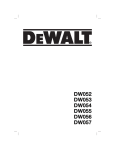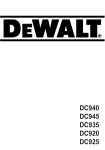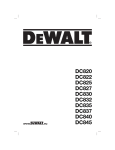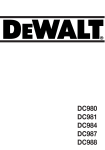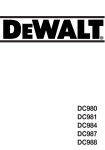Download DeWalt DC385 Technical data
Transcript
DC380 DC385 Figure 1 b c a d e f Figure 2 i h f g d i 1 Figure 3 j c Figure 4 Figure 5 k d 2 ENGLI S H HEAVY-DUTY CORDLESS RECIPROCATING SAW DC380, DC385 Congratulations! CAUTION: Indicates a potentially hazardous situation which, if not avoided, may result in minor or moderate injury. You have chosen a DEWALT tool. Years of experience, thorough product development and innovation make DEWALT one of the most reliable partners for professional power tool users. CAUTION: Used without the safety alert symbol indicates a potentially hazardous situation which, if not avoided, may result in property damage. Technical data Voltage Max. power output No-load speed Stroke length Weight (without battery pack) Battery pack Battery type Voltage Capacity Weight Charger Mains voltage Battery type Approx. charging time Weight Fuses Europe U.K. & Ireland VDC W min-1 mm DC380 18 340 0-2,900 25.4 DC385 18 390 0-3,000 28.6 kg 2.1 2.7 VDC Ah kg DE9096 NiCd 18 2.4 1.0 DE9503 NiMH 18 2.6 1.0 DE9116 230 NiCd/NiMH 60/70 0.4 DE9130 230 NiCd/NiMH 30/40 0.52 VAC min kg 230 V tools 10 Amperes, mains 230 V tools 13 Amperes, in plugs Definitions: Safety Guidelines Denotes risk of electric shock. EC-Declaration of conformity DC380, DC385 DEWALT declares that these tools and chargers have been designed in compliance with: 98/37/EC,89/336/EEC, 73/23/EEC, EN 55014-2, EN 55014-1, EN 60335, EN 60745, EN 61000-3-2 & EN 61000-3-3. For more information, please contact DEWALT at the address below, or refer to the back of the manual. Sound pressure (LpA) Acoustic power (LWA) Weighted RMS acceleration value dB(A dB(A) m/s2 Sound pressure uncertainty (KpA) Acoustic power uncertainty (KWA) dB(A) dB(A) DC380 DC385 89 87 100 98 12 19.9 2.8 2.8 Director Engineering and Product Development Horst Grossmann The definitions below describe the level of severity for each signal word. Please read the manual and pay attention to these symbols. DANGER: Indicates an imminently hazardous situation which, if not avoided, will result in death or serious injury. WARNING: Indicates a potentially hazardous situation which, if not avoided, could result in death or serious injury. 22 3 3 DEWALT, Richard-Klinger-Strase 11D-65510, Idstein, Germany 11/2006 ENGLISH General Safety Rules WARNING! Read all instructions. Failure to follow all instructions listed below may result in electric shock, fire and/or serious injury. The term “power tool” in all of the warnings listed below refers to your mains-operated (corded) power tool or battery-operated (cordless) power tool. SAVE THESE INSTRUCTIONS 1) WORK AREA SAFETY a) Keep work area clean and well lit. Cluttered or dark areas invite accidents. b) Do not operate power tools in explosive atmospheres, such as in the presence of flammable liquids, gases or dust. Power tools create sparks which may ignite the dust or fumes. c) Keep children and bystanders away while operating a power tool. Distractions can cause you to lose control. 2) ELECTRICAL SAFETY a) Power tool plugs must match the outlet. Never modify the plug in any way. Do not use any adapter plugs with earthed (grounded) power tools. Unmodified plugs and matching outlets will reduce risk of electric shock. b) Avoid body contact with earthed or grounded surfaces such as pipes, radiators, ranges and refrigerators. There is an increased risk of electric shock if your body is earthed or grounded. c) Do not expose power tools to rain or wet conditions. Water entering a power tool will increase the risk of electric shock. d) Do not abuse the cord. Never use the cord for carrying, pulling or unplugging the power tool. Keep cord away from heat, oil, sharp edges or moving parts. Damaged or entangled cords increase the risk of electric shock. e) When operating a power tool outdoors, use an extension cord suitable for outdoor use. Use of a cord suitable for outdoor use reduces the risk of electric shock. 3) PERSONAL SAFETY a) Stay alert, watch what you are doing and use common sense when operating a power tool. Do not use a power tool while you are tired or under the influence of drugs, alcohol or medication. A moment of inattention while operating power tools may result in serious personal injury. b) Use safety equipment. Always wear eye protection. Safety equipment such as dust mask, non-skid safety shoes, hard hat, or hearing protection used for appropriate conditions will reduce personal injuries. c) Avoid accidental starting. Ensure the switch is in the off-position before plugging in. Carrying power tools with your finger on the switch or plugging in power tools that have the switch on invites accidents. d) Remove any adjusting key or wrench before turning the power tool on. A wrench or a key left attached to a rotating part of the power tool may result in personal injury. e) Do not overreach. Keep proper footing and balance at all times. This enables better control of the power tool in unexpected situations. f) Dress properly. Do not wear loose clothing or jewellery. Keep your hair, clothing and gloves away from moving parts. Loose clothes, jewellery or long hair can be caught in moving parts. g) If devices are provided for the connection of dust extraction and collection facilities, ensure these are connected and properly used. Use of these devices can reduce dust-related hazards. 4) POWER TOOL USE AND CARE a) Do not force the power tool. Use the correct power tool for your application. The correct power tool will do the job better and safer at the rate for which it was designed. b) Do not use the power tool if the switch does not turn it on and off. Any power tool that cannot be controlled with the switch is dangerous and must be repaired. c) Disconnect the plug from the power source before making any adjustments, changing accessories, or storing power tools. Such preventive safety measures reduce the risk of starting the power tool accidentally. d) Store idle power tools out of the reach of children and do not allow persons unfamiliar with the power tool or these instructions to operate the power tool. 23 ENGLI S H Power tools are dangerous in the hands of untrained users. e) Maintain power tools. Check for misalignment or binding of moving parts, breakage of parts and any other condition that may affect the power tools operation. If damaged, have the power tool repaired before use. Many accidents are caused by poorly maintained power tools. f) Keep cutting tools sharp and clean. Properly maintained cutting tools with sharp cutting edges are less likely to bind and are easier to control. g) Use the power tool, accessories and tool bits etc., in accordance with these instructions and in the manner intended for the particular type of power tool, taking into account the working conditions and the work to be performed. Use of the power tool for operations different from those intended could result in a hazardous situation. 5) BATTERY TOOL USE AND CARE a) Ensure the switch is in the off position before inserting battery pack. Inserting the battery pack into power tools that have the switch on invites accidents. b) Recharge only with the charger specified by the manufacturer. A charger that is suitable for one type of battery pack may create a risk of fire when used with another battery pack. c) Use power tools only with specifically designated battery packs. Use of any other battery packs may create a risk of injury and fire. d) When battery pack is not in use, keep it away from other metal objects like paper clips, coins, keys, nails, screws, or other small metal objects that can make a connection from one terminal to another. Shorting the battery terminals together may cause burns or a fire. e) Under abusive conditions, liquid may be ejected from the battery, avoid contact. If contact accidentally occurs, flush with water. If liquid contacts eyes, additionally seek medical help. Liquid ejected from the battery may cause irritation or burns. 6) SERVICE a) Have your power tool serviced by a qualified repair person using only identical replacement parts. This will ensure that the safety of the power tool is maintained. Additional Safety Instructions for Battery Packs WARNING: Fire hazard! Avoid metal short circuiting the contacts of a detached battery pack. Do not store or carry the battery pack without the battery cap placed over the contacts. • The battery fluid, a 25-30% solution of potassium hydroxide, can be harmful. In case of skin contact, flush immediately with water. Neutralize with a mild acid such as lemon juice or vinegar. In case of eye contact, rinse abundantly with clean water for at least 10 minutes. Consult a physician. • Never attempt to open a battery pack for any reason. Additional Safety Instructions for Battery Packs and Chargers • Make sure that the battery pack is dry and clean before inserting it into the charger. • Use only chargers labelled “NiMH” or “NiMH + NiCd” to charge DEWALT NiMH battery packs. • Never carry the charger by its cord. Never pull the cord to disconnect from the socket. Keep the cord away from heat, oil and sharp edges. • Do not expose the charger to damp or wet conditions. • Do not attempt to charge wet battery packs. • Never attempt to open a battery pack for any reason. • Always follow the instructions in the back of this manual for battery pack disposal. • When not in use, chargers and battery packs must be stored in a dry place and locked up securely, out of reach of children. LABELS ON CHARGER AND BATTERY PACK In addition to the pictographs used in this manual, the labels on the charger and the battery pack show the following pictographs: Battery charging Battery charged Battery defective 24 ENGLISH Hot/cold pack delay Do not probe with conductive objects. Do not charge damaged battery packs Read instruction manual before use. Use only with DEWALT battery packs, others may burst, causing personal injury and damage. Do not expose to water. wires which may be hidden from view. Anticipate the path of falling branches and debris ahead of time. • Do not operate this tool for long periods of time. Vibration caused by the operating action of this tool may cause permanent injury to fingers, hands, and arms. Use gloves to provide extra cushion, take frequent rest periods, and limit daily time of use. SWITCHING ON AND OFF • After switching off, never attempt to stop the saw blade with your fingers. • Never put the saw down on a table or work bench unless switched off. The saw blade will keep running briefly after the tool has been switched off. WHEN SAWING Have defective cords replaced immediately. • When using saw blades specially designed for cutting wood remove all nails and metal objects from the workpiece before starting work. Charge only between 4 °C and 40 °C. • Wherever possible, use clamps and vices to fasten the workpiece securely. Discard the battery pack with due care for the environment. • Do not attempt to saw extremely small workpieces. Do not incinerate the battery pack NiMH/ NiCd+. • Do not bend too far forward. Make sure that you always stand firmly, particularly on scaffolding and ladders. • Always hold the saw with both hands. Charges NiMH and NiCd battery packs. • For cutting curves and pockets, use an adapted saw blade. CHECKING AND CHANGING THE SAW BLADE See technical data for charging time. Additional Safety Instructions for Reciprocating Saws • Hold tool by insulated gripping surfaces when performing an operation where the cutting tool may contact hidden wiring or its own cord. Contact with a "live" wire will also make exposed metal parts of the tool "live" and shock the operator. • NEVER switch on the tool when the saw blade is jammed in the workpiece or in contact with the material. • Keep hands away from moving parts. Never place your hands near the cutting area. • Use extra caution when cutting overhead and pay particular attention to overhead • Only use saw blades conforming to the specifications contained in these operating instructions. • Only sharp saw blades in perfect working condition should be used; cracked or bent saw blades should be discarded and replaced at once. • Ensure that the saw blade is securely fixed. Do not use the tool on a ladder. Package Contents The DC380 package contains: 1 Cordless reciprocating saw 1 Saw blade 2 Battery packs, NiCd (DC380KA) 2 Battery packs, NiMH (DC380KB) 25 ENGLI S H 1 Charger (DC380KA/DC380KB) Electrical Safety 1 Kitbox (DC380KA/DC380KB) The electric motor has been designed for one voltage only. Always check that the battery pack voltage corresponds to the voltage on the rating plate. Also make sure that the voltage of your charger corresponds to that of your mains. 1 Instruction manual 1 Exploded drawing The DC385 package contains: 2 Battery packs, NiCd (DC385KA) 2 Battery packs, NiMH (DC385KB) 1 Charger (DC385KA/DC385KB) 1 Kitbox (DC385KA/DC385KB 1 Instruction manual 1 Exploded drawing NOTE: Battery packs and chargers are not included with N-models. • Check for damage to the tool, parts or accessories which may have occurred during transport. • Take the time to thoroughly read and understand this manual prior to operation. Description (fig. 1) WARNING: Never modify the power tool or any part of it. Damage or personal injury could result. INTENDED USE Your DC380, DC385 cordless reciprocating saws have been designed for professional sawing of wood, metal and tubes. The compact design permits cutting extremely close to the edge of difficult areas. DO NOT use under humid conditions or in presence of flammable liquids or gases. The DC380, DC385 cordless reciprocating saws are professional power tools. DO NOT let children come into contact with the tool. Supervision is required for those under 16 years of age. a. Variable speed switch b. Lock-off button Your DEWALT charger is double insulated in accordance with EN 60335. Mains Plug Replacement (U.K. & Ireland only) DANGER: • Should your mains plug need replacing and you are competent to do this, proceed as instructed below. If you are in doubt, contact an authorized DEWALT repair agent or a qualified electrician. • Disconnect the plug from the supply. • Cut off the plug and dispose of it safely; a plug with bared copper conductors is dangerous if engaged in a live socket outlet. • Only fit 13 Amperes BS1363A approved plugs fitted with the correctly rated fuse (1). • The cable wire colours, or a letter, will be marked at the connection points of most good quality plugs. Attach the wires to their respective points in the plug (see below). Brown is for Live (L) (2) and Blue is for Neutral (N) (4). • Before replacing the top cover of the mains plug ensure that the cable restraint (3) is holding the outer sheath of the cable firmly and that the two leads are correctly fixed at the terminals crews. 1 2 4 3 c. Blade clamp lever d. Saw shoe WARNING: NEVER use a light socket. e. Battery pack NEVER connect the live (L) or neutral (N) wires to the earth . pin marked E or f. Battery release buttons g. Charger h. Charging indicator (red) Charger The DE9116/DE9130 chargers accept DEWALT NiCd and NiMH battery packs ranging from 7.2 to 18 V. 26 Using an Extension Cable An extension cord should not be used unless absolutely necessary. Use an approved extension cable suitable for the power input of your charger (see technical data). The minimum conductor size is 1 mm2; the maximum length is 30 m. ENGLISH Assembly and Adjustment WARNING: Prior to assembly and adjustment, always remove the battery pack. Always switch off the tool before inserting or removing the battery pack. WARNING: Use only DEWALT battery packs and chargers. Battery Pack (fig.1) DC380, DC385 BATTERY TYPE The DC380 and DC385 operate on 18 volt battery packs. Charging the Battery Pack (fig. 2) When charging the battery pack (d) for the first time, or after prolonged storage, it will only accept an 80% charge. After several charge and discharge cycles, the battery pack will attain full capacity. Always check the mains prior to charging the battery pack. If the mains is functioning but the battery pack does not charge, take your charger to an authorised DEWALT repair agent. Whilst charging, the charger and the battery pack may become warm to touch. This is a normal condition and does not indicate a problem. WARNING: Do not charge the battery pack at ambient temperatures < 4 °C or > 40 °C. Recommended charging temperature: approx. 24 °C. To charge the battery pack (e), insert it into the charger (o) as shown and plug in the charger. Be sure that the battery pack is fully seated in the charger. The red charging indicator (h) will blink. After approx. 1 hour/30 minutes (depending on charger), it will stop blinking and remain on. The battery pack is now fully charged. The battery pack can be removed at any time or left in the connected charger for a longer period of time (with a maximum of 14 days). Inserting and Removing the Battery Pack from the Tool 1. Insert the battery pack (e) into the grip until it clicks in place. 2. To remove the battery pack, press the two battery release buttons (f simultaneously and pull the pack out of the grip. Battery Cap (fig. 2) A protective battery cap (i) is supplied to cover the contacts of a detached battery pack. Without the protective cap in place, loose metal objects could short circuit the contacts, causing a fire hazard and damaging the battery pack. 1. Take off the protective battery cap (i) before placing the battery pack (e) in the charger or tool. 2. Place the protective cap over the contacts immediately after removing the battery pack from the charger or tool. WARNING: Make sure the protective battery cap is in place before storing or carrying a detached battery pack. Automatic Refresh The automatic refresh mode will equalize or balance the individual cells in the battery pack at its peak capacity. Battery packs should be refreshed overnight after every 10th charge/discharge cycle or whenever the pack no longer delivers the same amount of work. To refresh your battery pack, place it in the charger as usual. The red light will blink continuously indicating that the charge cycle has started. When the 1-hour/30-minute charge cycle (depending on charger) has completed, the light will stay on continuously and will no longer blink. The battery pack is fully charged and can be used at this time. If the battery pack is left in the charger after the initial 1-hour/30-minute charge (depending on charger), the charger will automatically initiate the refresh mode. This mode will continue up to 8 hours, but the battery pack can be removed at any time during the refresh mode. Hot/Cold Pack Delay When the charger detects a battery pack that is too hot or too cold, it automatically starts a Hot/Cold Pack Delay, suspending charging until the battery has reached an appropriate temperature. The charger then automatically switches to the pack charging mode. This feature ensures maximum battery life. The red indicator blinks long, then short while in the Hot/Cold Pack Delay mode. ASSEMBLY Replacing the Saw Blade (fig. 3, 4) 1. Move the blade clamp lever (c) up to release the blade clamping mechanism. 2. Insert the saw blade into the holder (j) until it engages. The blade can be installed with the 27 ENGLI S H teeth pointing down, up, left or right, as shown in figure 4. 3. Move the blade clamp lever (c) down to lock the blade clamping mechanism. 4. To remove the saw blade, proceed in reverse order. SAW BLADES material ferrous metal non ferrous metal wood plastic masonry recommended saw blade fine-toothed coarse-toothed coarse-toothed fine-toothed carbide-tipped A wide variety of dedicated saw blades is available as an option. CAUTION: To reduce the risk of damage to the workpiece, always select your saw blade with great care. Setting the Adjustable Saw Shoe (fig. 5) The saw shoe can be adjusted to limit the depth of cut and prolong the life of your saw blade. 1. Push and hold the shoe release button (k). 2. Slide the saw shoe (d) into one of the three settings. 3. Release the shoe release button. Instructions for Use WARNING: • Always observe the safety instructions and applicable regulations. • Ensure the material to be sawn is secured in place. • Apply only a gentle pressure to the tool and do not exert side pressure on the saw blade. If possible, work with the saw shoe pressed against the workpiece. This prevents damage to the blade and stops the tool from jerking and vibrating. • Avoid overloading. • Let the blade run freely for a few seconds before starting the cut. WARNING: ALWAYS use NIOSH/ OSHA/MSHA-approved respiratory protection. Prolonged contact with dust may be hazardous to your health. 28 Prior to operation, make sure your battery pack is (fully) charged. OPERATION WARNING: Turn unit off and disconnect battery pack before installing and removing accessories, before adjusting or when making repairs. Lock the trigger switch when the tool is not in use and when storing the tool. WARNING: Always wear proper personal hearing protection that conforms to ANSI S12.6 (S3.19) during use. Under some conditions and duration of use, noise from this product may contribute to hearing loss. Switching On and Off (fig. 1) For safety reasons the variable speed switch (a) is equipped with a lock-off button (b). 1. Press the lock-off button (b) to unlock the tool. 2. To run the tool, press the variable speed switch (a). The pressure exerted on the variable speed switch determines the tool speed. 3. To stop the tool, release the switch. CAUTION: Do not switch the tool ON or OFF when the saw blade touches the workpiece or other materials. Cutting Wood • Clamp the workpiece securely and remove all nails and metal objects. • Holding the tool with both hands, work with the saw shoe pressed against the workpiece. Plunge Cutting in Wood 1. Rest the saw shoe on the workpiece in such a position that the blade forms an appropriate angle for the plunge cut. 2. Switch the tool on and slowly feed in the blade. Make sure that the saw shoe remains in contact with the workpiece at all times. Pocket Cuts 1. Measure and mark the required pocket cut. 2. Using a narrow saw blade rest the bottom of the saw shoe on the workpiece and make sure that the blade is positioned on the cutting line. ENGLISH If necessary, e.g. in confined spaces, use the outer edge of the saw shoe as your guideline. 3. Switch on the tool and feed the blade into the material at full speed, holding the tool firmly against the workpiece. Cleaning • Unplug the charger before cleaning the housing with a soft cloth. • Remove the battery pack before cleaning your power tool. Dust Extraction When the tool is used indoor for extended periods of time, use a suitable dust extractor designed in compliance with the applicable Directives regarding dust emission. Cutting Metal • When cutting thin metal always stabilize the workpiece with wood on both sides. This guarantees clean cuts and prevents damaging of the material. • Keep the ventilation slots clear and regularly clean the housing with a soft cloth. Optional Accessories WARNING: Since accessories, other than those offered by DEWALT, have not been tested with this product, use of such accessories with this tool could be hazardous. To reduce the risk of injury, only DEWALT, recommended accessories should be used with this product. • For long, straight cuts draw a line on the workpiece. Consult your dealer for further information on the appropriate accessories. • Apply a thin film of lubricant along the cutting line, switch on the tool and follow the cutting line. Protecting the Environment Cutting Plastics Separate collection. This product must not be disposed of with normal household waste. Always work at reduced speed. Carry out a test cut to check whether the material is sensitive to heat. Cutting Masonry WARNING: When sawing asbestos cement hazardous dust may be produced. Follow the statutory guidelines and observe the recommendations issued by the asbestos cement manufacturers. MAINTENANCE Your DEWALT power tool has been designed to operate over a long period of time with a minimum of maintenance. Continuous satisfactory operation depends upon proper tool care and regular cleaning. Lubrication This tool requires no lubrication. Should you find one day that your DEWALT product needs replacement, or if it is of no further use to you, do not dispose of it with household waste. Make this product available for separate collection. Separate collection of used products and packaging allows materials to be recycled and used again. Re-use of recycled materials helps prevent environmental pollution and reduces the demand for raw materials. Local regulations may provide for separate collection of electrical products from the household, at municipal waste sites or by the retailer when you purchase a new product. DEWALT provides a facility for the collection and recycling of DEWALT products once they have reached the end of their working life. To take advantage of this service please return your product to any authorised repair agent who will collect them on our behalf. 29











